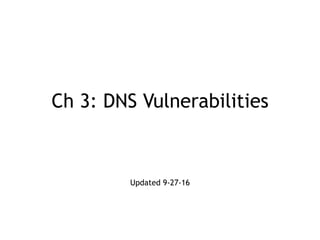
CNIT 40: 3: DNS vulnerabilities
- 1. Ch 3: DNS Vulnerabilities Updated 9-27-16
- 2. Causes of Vulnerabilities • Configuration errors • Architecture mistakes • Vulnerable software implementations • Protocol weaknesses • Failure to use the security extensions in the protocol
- 4. Single Point of Failure • The SOA could be a single server at a single site – If the server crashes, clients would be unable to resolve any of the domains in the zone – Also Internet connection outage, power failure, fire, storm, etc. • If a single server is the recursive resolver for clients in an intranet – They'll all lose DNS service if it goes gown
- 5. Two Servers • Many hosting providers do not allow delegation of DNS service to a single DNS server name • End devices are typically provisioned with two DNS server addresses
- 7. Data Center or Single Site • If all DNS servers are at a single site or data center, a regional event could take them all down – Earthquake – Power failure • The more critical the DNS service is, the more distributed servers should be – Geographically and topologically – Like the 13 root servers
- 9. Exposure of Internal Information • Only public Web-facing servers should be in the external DNS zone files • Your DNS server is a target of attack and may be compromised
- 11. Leakage of Internal Queries to the Internet • Some Windows DHCP clients leak dynamic DNS updates to the Internet – Link Ch 3a
- 12. Windows Versions • These packets were sent from Windows 2000, Windows XP, and Server 2003 – When tested in 2006 • To prevent this, configure local DNS servers not to refer internal machines to external name servers – And block DNS requests directly to the Internet
- 13. Unnecessary Recursiveness • Not all name servers need to be recursive – Authoritative servers don't need to – Recursion is complex and burdens servers – Added function means more potential vulnerabilities • Recursion may be on by default – Thousands of open recursive resolvers on the Internet
- 14. Failure to Restrict Access • Recursive DNS servers should only accept queries from your own clients – Block outside addresses with access control lists
- 15. Open Resolver Project • Link Ch 3b
- 16. Testing CCSF's DNS Servers in 2016
- 17. Testing CCSF's DNS Servers • All are closed as of 9-27-16
- 18. Unprotected Zone Transfers • Data transfers from a master to a slave authoritative server – Update the zone files on the slave • Can be requested by any other host • Reveals information about all hosts in the zone – Information disclosure vulnerability
- 19. North Korea • Link Ch 3i
- 20. Running Server in Privileged Mode • root on Unix/Linux • Administrator on Windows – Makes any security flaws more dangerous – Attacker who owns DNS then owns the server
- 21. Weakness in Software Implementations • DNS servers have bugs and vulnerabilities – Buffer overflows – Other errors • Search CVE List for "ISC Bind"
- 23. Severe 2008 Bind Vulnerability • Attack used an IP address like – 1.2.3.4.xxxxxxxx-exploit-code-here-xxxx • Another list of DNS vulns at link Ch 3d
- 24. Source Port Randomization • Good video • Link Ch 3e
- 25. Randomness of Transaction ID • Each DNS query and response has a TXID field – 16 bits long (65,536 possible values) – Should be random • Bind 8 & 9 used predictable transaction IDs – So only ten guesses were needed to spoof the reply
- 26. Randomness of Transaction ID
- 27. Tricking a Target into Using Your DNS Server • Run a domain evil.com with a SOA you control ns1.evil.com – Send the target an email with a link to server.evil.com and hope someone clicks it – Send email from joe@evil.com to target email address • The server will automatically perform a reverse lookup to detect spam
- 28. Tricking a Target into Making Multiple DNS Queries • CNAME Chaining – www.evil.com is a CNAME for www1.evil.com – www1.evil.com is a CNAME for www2.evil.com – www2.evil.com is a CNAME for www3.evil.com – etc.
- 29. Tricking a Target into Making Multiple DNS Queries • NS Referral Chaining and NS Chains – a.a.a.a.evil.com has SOA ns.evil.com – ns.evil.com delegates to ns.a.evil.com – ns.a.evil.com delegates to ns.a.a.evil.com – etc.
- 31. Weak Authentication • DNS uses these elements to match a request and a response – Transaction ID (16 bits) – Question – Source and destination IP – Source and destination ports • But request destination port is known (53) • Client accepts the first response that meets these criteria, and caches the result
- 32. DNS Cache Poisoning • A false response that tricks the client puts a false entry into its cache
- 33. DNS Cache Poisoning Attacker 1.2.3.4 DNS Resolver Target Where is www.yahoo.com?www.yahoo.com is at 1.2.3.4 Where is www.yahoo.com? www.yahoo.com is at 1.2.3.4
- 34. • Link Ch 3f
- 35. • Link Ch 3g
- 36. Consequences of the Kaminsky Attack • Attack can be placed in a Web page – Many img tags – <img src=aaaa.paypal.com> – <img src=aaab.paypal.com> – <img src=aaac.paypal.com> – <img src=aaad.paypal.com> – etc. • If one Comcast customer views that page, all other Comcast customers will be sent to the fake paypal.com • Poisoning can take as few as 10 seconds
- 37. Man-in-the-Middle Attacks • Attacker in the middle has enough info to perfectly forge responses – Unless DNSSEC is used Attacker DNS ResolverTarget
- 38. DNS as a DoS Amplifier • Small requests lead to large responses • UDP allows spoofing the source IP address AttackerOpen DNS ResolverTarget
